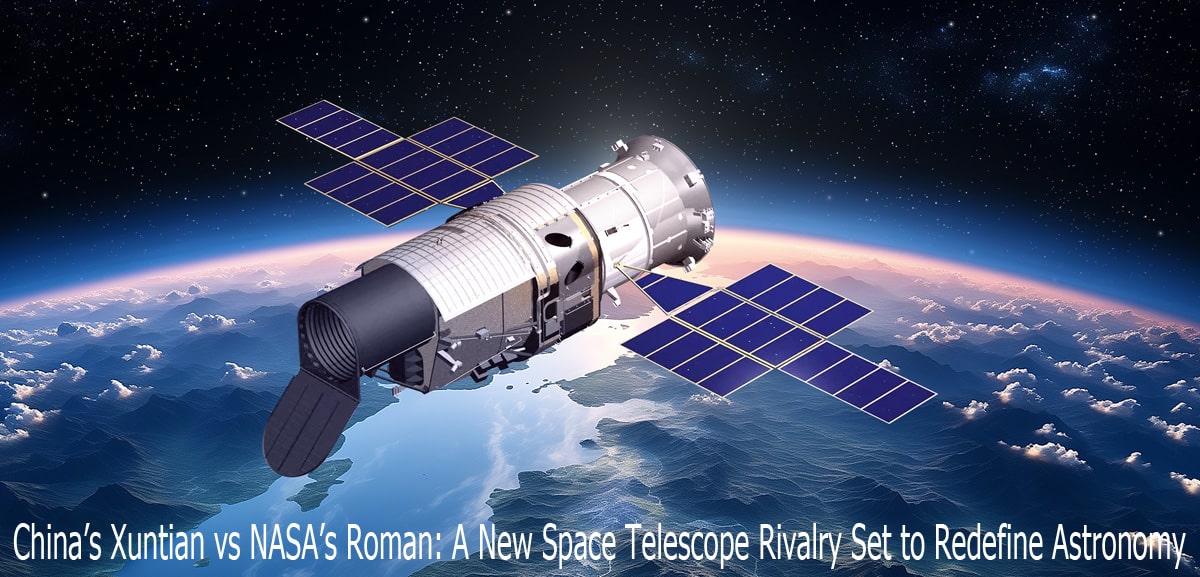June 2025 — In a landmark era for astronomy, two of the world’s most advanced space telescopes are preparing for liftoff — China’s Xuntian and the United States’ Nancy Grace Roman Space Telescope. While separated by national space agendas, both missions are united in their ambition: to revolutionize our understanding of the universe.
China’s Xuntian, also known as the Chinese Survey Space Telescope, and NASA’s Roman Telescope are expected to launch around 2026. Though often compared to the Hubble Space Telescope, both new instruments are built for far more ambitious scientific goals, equipped with wider fields of view, modern sensors, and unique mission designs.
What is Xuntian? China’s Biggest Space Observatory Yet
“Heavenly Cruiser,” or Xuntian, is China’s most ambitious space observatory to date. Designed with a 2-meter primary mirror and an ultra-wide-field view, Xuntian will survey about 40% of the sky over its 10-year mission — making it one of the most powerful survey telescopes ever deployed.
Unlike Hubble or Roman, Xuntian will co-orbit with China’s Tiangong space station in low Earth orbit (LEO). This proximity allows it to dock for maintenance or upgrades, providing China with a significant operational advantage.
Xuntian carries five advanced instruments, including a 2.5-billion-pixel main survey camera, a multichannel imager, spectrographs, and even a terahertz detector — a rare capability in space telescopes. Its sensitivity spans from the near-ultraviolet to the near-infrared range, enabling comprehensive studies of galaxy formation, cosmic evolution, dark matter mapping, and fast transients like supernovae.
Originally planned for launch in 2023, Xuntian has faced several technical delays. As of mid-2025, the Chinese Academy of Sciences confirms that all major components have completed integration and environmental testing. Late 2026 is currently anticipated to be the most recent launch window.
NASA’s Roman: A Hubble-Sized Mirror with a Survey-Driven Mission
NASA’s Roman Space Telescope is getting ready to launch on a SpaceX Falcon Heavy in May 2027, which is on the opposite side of the world. The telescope features a 2.4-meter mirror — identical in size to Hubble’s — but paired with a Wide Field Instrument capable of imaging 100 times more sky per snapshot.
Roman’s scientific arsenal includes two major instruments: the Wide Field Instrument (300-megapixel near-infrared camera) and a Coronagraph, which will demonstrate direct imaging of exoplanets by blocking starlight. Operating from the Sun–Earth L2 Lagrange Point, Roman will enjoy thermal stability and uninterrupted views of the cosmos, making it ideal for precise cosmological studies.
NASA aims to use Roman for wide-area dark energy mapping, detecting exoplanets via microlensing, and capturing thousands of distant supernovae. Unlike Xuntian, Roman will not be serviceable due to its deep-space location, emphasizing reliability and redundancy in its design.
Key Differences: What Sets Them Apart?
| Feature | Xuntian | Roman |
| Mirror Size | 2.0 meters | 2.4 meters |
| Field of View | ~300× Hubble | ~100× Hubble |
| Wavelengths | Near-UV to Near-IR | Near-IR (0.48–2.3 µm) |
| Space | Earth’s Low Orbit (with Tiangong) | L2 (1.5 million kilometers away from Earth) |
| Servicing | Yes (can dock with space station) | No (not serviceable) |
| Launch Date | Late 2026 (expected) | May 2027 (committed) |
Despite their differences, the two missions are highly complementary. Xuntian’s ultraviolet and optical capabilities fill a gap left by the now-retired GALEX and support synergy with Roman’s infrared observations. Together, they will provide an unprecedented multi-wavelength view of the cosmos.
Why This Race Matters for Science
The global space community is watching this “telescope race” not as a competition, but as a promise of extraordinary scientific return. While both China and the U.S. are leading these projects independently, the data from Roman and Xuntian are expected to support global research, including joint projects, data comparisons, and possibly open archives.
According to Dr. Ming Li of the Chinese National Space Science Center, “Xuntian is not just a national project — it’s a scientific infrastructure for all humankind.” Similarly, NASA has committed Roman’s data to public release for international collaboration.
The coming years may see humanity’s most detailed sky maps yet — mapping billions of galaxies, detecting thousands of new exoplanets, and offering deep insights into dark energy and the universe’s expansion.
Conclusion: The Dawn of a New Golden Age of Telescopes
Roman and Xuntian’s concurrent development signals the start of a new era in space-based astronomy rather than a duel. With different strengths but similar ambitions, both telescopes will work in parallel to reshape our understanding of the cosmos.
As 2026 approaches, scientists and stargazers alike can look forward to a decade defined by data, discovery, and awe — from both East and West.



